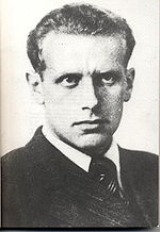
Boris Vildé
Encyclopedia
Boris Vildé was a linguist and ethnographer at the Musée de l'Homme
, in Paris
, France. He specialised in polar civilizations. He was born in St. Petersburg into a family of Eastern orthodox Russians
. His family moved to Tartu
, Estonia
in 1919. He studied at the University of Tartu
, before moving to France.
Vildé was active in the French Resistance
during World War II
. During the resistance he led the scientists and lawyers of the Groupe du musée de l'Homme
in producing an anti-Nazi and Vichy newspaper, called Résistance. The group, one of the first résistance units, was infiltrated by a Vichy supporter and as a result most of them were arrested, tried and the men among them sentenced to death. He was killed by firing squad, together with Léon-Maurice Nordmann, Georges Ithier, Jules Andrieu, René Sénéchal, Pierre Walter and Anatole Lewitsky
, on 23 February 1942 at Fort Mont-Valérien
. They are buried in the cemetery at Ivry-sur-Seine
.
Musée de l'Homme
The Musée de l'Homme was created in 1937 by Paul Rivet for the 1937 Exposition Internationale des Arts et Techniques dans la Vie Moderne. It is the descendant of the Musée d'Ethnographie du Trocadéro, founded in 1878...
, in Paris
Paris
Paris is the capital and largest city in France, situated on the river Seine, in northern France, at the heart of the Île-de-France region...
, France. He specialised in polar civilizations. He was born in St. Petersburg into a family of Eastern orthodox Russians
Russians
The Russian people are an East Slavic ethnic group native to Russia, speaking the Russian language and primarily living in Russia and neighboring countries....
. His family moved to Tartu
Tartu
Tartu is the second largest city of Estonia. In contrast to Estonia's political and financial capital Tallinn, Tartu is often considered the intellectual and cultural hub, especially since it is home to Estonia's oldest and most renowned university. Situated 186 km southeast of Tallinn, the...
, Estonia
Estonia
Estonia , officially the Republic of Estonia , is a state in the Baltic region of Northern Europe. It is bordered to the north by the Gulf of Finland, to the west by the Baltic Sea, to the south by Latvia , and to the east by Lake Peipsi and the Russian Federation . Across the Baltic Sea lies...
in 1919. He studied at the University of Tartu
University of Tartu
The University of Tartu is a classical university in the city of Tartu, Estonia. University of Tartu is the national university of Estonia; it is the biggest and highest-ranked university in Estonia...
, before moving to France.
Vildé was active in the French Resistance
French Resistance
The French Resistance is the name used to denote the collection of French resistance movements that fought against the Nazi German occupation of France and against the collaborationist Vichy régime during World War II...
during World War II
World War II
World War II, or the Second World War , was a global conflict lasting from 1939 to 1945, involving most of the world's nations—including all of the great powers—eventually forming two opposing military alliances: the Allies and the Axis...
. During the resistance he led the scientists and lawyers of the Groupe du musée de l'Homme
Groupe du musée de l'Homme
The Groupe du musée de l'Homme was a movement in the French resistance to the Nazi occupation during the Second World War....
in producing an anti-Nazi and Vichy newspaper, called Résistance. The group, one of the first résistance units, was infiltrated by a Vichy supporter and as a result most of them were arrested, tried and the men among them sentenced to death. He was killed by firing squad, together with Léon-Maurice Nordmann, Georges Ithier, Jules Andrieu, René Sénéchal, Pierre Walter and Anatole Lewitsky
Anatole Lewitsky
Anatole Lewitsky was a French anthropologist and member of the French Resistance in World War II. He was head of the European-Asiatic department at the Musée de l'Homme, and a world authority on Siberian shamanism....
, on 23 February 1942 at Fort Mont-Valérien
Fort Mont-Valérien
Fort Mont-Valérien is a fortress in Suresnes a western Paris suburb, built in 1841 as part of the city's ring of modern fortifications...
. They are buried in the cemetery at Ivry-sur-Seine
Ivry-sur-Seine
Ivry-sur-Seine is a commune in the Val-de-Marne department in the southeastern suburbs of Paris, France. It is located from the center of Paris....
.

